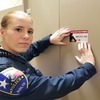Exploding issue with strays
An out-of-control stray population impacting animal shelters and rescues trying to keep up with Cherokee County’s needs is spilling over into local communities trying to enforce animal control policies.
“Our problem is unwanted and stray animals – we just don’t know what to do with them,” said New Summerfield Police Chief Fred Butler, noting that approximately 90% of the department’s animal complaint calls deal with strays. “And there’s nothing worse than going to one of those calls, talking to people and then telling them I have no place to take them.”
According to statistics compiled by thezebra.com from sources like the ASPCA, the Humane Society, Bestfriends.org and PetPedia, there are approximately 6.5 million animals entering shelters each year, with just 3.2 million adopted. The site also noted that U.S. has about 3,500 brick-and-mortar animal shelters, and 99% of all shelter animals are healthy enough to be adopted.
But the animals are coming in more quickly than they are leaving the area, be it through adoption, foster or transport to out-of-state rescues partnering with the local shelters.
Organizations like the Jacksonville-based County Road Rescue issue ongoing pleas for pet owners to spay or neuter their animals because otherwise, the population explosion of dogs and cats will grow to proportions that will be even harder to manage.
According to CRR director Dava Cooley, the local rescue receives an average of nine requests daily to take in strays, but it’s not possible.
“If we responded to every call, we would have to take in about 3,285 animals a year, compared to our current 200 a year. For a county our size (population-wise), this number is staggering, and for a rescue organization our size, this number is impossible,” she said, adding that “each female cat or dog and her babies can produce 67,000 babies over a 6-year period!”
Butler said it’s not just CCR facing this problem.
“Anytime you call a shelter for help, they’re always filled, and there’s a few in the area that we call,” he said.
Like a number of other communities, New Summerfield has adopted ordinances focusing on animal control, such as leash laws, but the real problem comes when animals are dumped for whatever reason, Butler said.
“It’s pretty much country here, and people will dump animals on the side of the road,” Butler said. “We get 5-6 calls a month on stray animals that we cannot find an owner.”
In other places, like Wells, there is even less recourse.
“If we know who the owner of the dog or cat is, we contact them to pick up their pet,” said City Secretary Melanie Pounds. “Or, whoever calls in can catch it, can take that animal to the pound … we don’t have a dog-catcher and the county does not handle calls inside the city.”
In Rusk, where city leaders have adopted different animal ordinances, members of the public works department provide animal control whenever an animal at large call goes out, said Public Works Director Neill Holcomb said.
“Someone is sent out to that address and they try to capture the animal using a catch stick or a live trap,” he said.
A photo of the animal is posted to social media, and owners are invited to reunite with their missing pet before a 72-hour stay expires at the small city-operated holding facility. Pet owners must offer proof of rabies vaccine to claim their pet; animals who are not claimed are taken to the Nacogdoches Animal Shelter, and placed for adoption.
Every effort is made to reunite pets and owners, to a point where residents are encouraged to contact city hall with photos and information of their missing pets so that the animals are more easily identifiable to animal control officials. “
“We contract with the Nacogdoches shelter, and we have to pay them to take our animals, so the city has to budget money for that,” Holcomb said. “So, if your pet is missing, please call and see if we’ve picked it up.”
Approximately 100 animals are sent to Nacogdoches each year because it is a no-kill shelter. “They do their best to rehome the animals they get,” he said.
In Cherokee County, officials reported receiving 1,823 animal control calls and/or complaints during 2022, or an average of 152.08 per month, primarily regarding loose livestock or animal endangerment, said Sheriff Brent Dickson.
The biggest challenge in dealing with stray dogs is finding a place that can take them, he said.
“We don’t have anywhere to go with animals because the rescues are full … we rely on rescues a lot, and our biggest issue is finding homes for these dogs to keep them from being killed,” Dickson said, adding he was grateful to the rescues who work with CCSO to home the animals.
At this time, Cherokee County does not have any ordinances or laws on the books that deal with animal control.
“I hope we can get with the county attorney and the commissioners’ court to get some ordinances passed,” Dickson said.
The City of Jacksonville, which operates an animal shelter at 208 E. Tena St., reported the following year-to-date figures as of May 2023: A total of 143 dogs and 58 cats have been processed as intakes this year, with 94 adopted or rescued dogs, 35 dogs reclaimed by their owners and 25 cats were adopted or rescued. There were no cats reclaimed by their owners, according to the data provided.
Jacksonville has various ordinances and statutes on the books pertaining to animals.
Please support The Cherokeean Herald by subscribing today!
